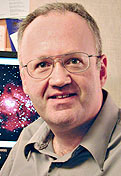 |
|
2008
January
28-31
|
Cowboy what?
Or are they just horsing around?
The latest fad to sweep evangelical Christendom, at least around here, is
cowboy churches where people wear boots and hats and may arrive on
horseback.
Google "cowboy church"
and you'll find some.
I'm in favor of bringing the Gospel to every subset of the population.
I certainly do not think God can only be approached by wearing a suit and tie.
But somehow
this whole thing strikes me as a big gimmick. A cowboy church is, by definition,
not a church for non-cowboys. Cowboy first, Christian second.
Or at least that's what it seems constantly on the verge of turning into.
Then there's the whole question of what gospel.
The second cowboy church that I found, on line, is apparently teaching the wholly erroneous
"prosperity gospel,"
which says that if you do what God commands, He'll make you rich.
That doctrine implies that if you're poor, you must not be living right.
And at this point we seem to be a long way away from Jesus, who never looked down
on the poor.
And that raises the issue of accountability.
When a free-lance evangelist goes out to an almost totally unchurched population,
nobody's going to stop him from dispensing heresy.
Permanent link to this entry
Short notes
I'm not going to say much about the election,
but please allow me to make one snarky comment.
Some of the news media seem to feel that
in order to show that we're against racism and sexism,
we must either vote for Obama because of his color,
or vote for Clinton because of her gender.
I'm closing out January now because I'm so busy.
See you in February!
Permanent link to this entry


|

|
2008
January
26-27
|
Gainfully employed
The alert reader will have gathered that I am keeping very busy with something other
than writing in this Notebook.
I tell people joining my research group that they have a choice of
curing disease or
preventing war.
Or both.
Who says we're not useful?
Permanent link to this entry


|

|
2008
January
25
|
Ghost of a departing comet

Comet Homes is still up there; in fact, it's almost the same direction from earth as it has
been since it came into view — the direction of the constellation Perseus.
Here you see it next to the star Algol. It's faint but big, about 1.5 degrees in diameter
in the picture, and I don't know whether there's fainter material on its periphery
that didn't show up.
Stack of three 1-minute exposures at ISO 800, Canon 40D, 105-mm lens at f/4.
Permanent link to this entry


|

|
2008
January
24
|
More miscellany
Music video for research astronomers:
Hotel Mauna Kea,
a remarkably well-performed spoof.
Here's
a big roundup on
how to make printed-circuit boards.
Down in Cuba,
people vote,
but they have absolutely no choice — there is only
one candidate for each office.
Remember that when you consider our bewildering variety in the primaries.
Geeks who can't tell right from wrong:
A group called Gizmodo
disrupted
the Consumer Electronics Show just for kicks.
They got their jollies by surreptitiously turning off other
people's video monitors using universal TV remote controls
(actually a gadget called "TV-Be-Gone"
that only transmits the "off" code).
They expected to be admired for such a clever prank,
even though it was very costly to the victims, who had paid
a small fortune for exhibit time and space.
Permanent link to this entry


|

|
2008
January
23
|
Miscellany
Have a look at
Rainy
Day Magazine (on line), especially the part that's about my books... I found out about this after it
was published.
Also enjoy an example of
humor
in a Tektronix circuit diagram.
(Yes, she's washing the face of a CRT. And
there are others.)
Finally, the true cause of the recession
may be online golf.
(Yes, I'm kidding.)
Permanent link to this entry


|

|
2008
January
22
|
Hallicrafters S-40B
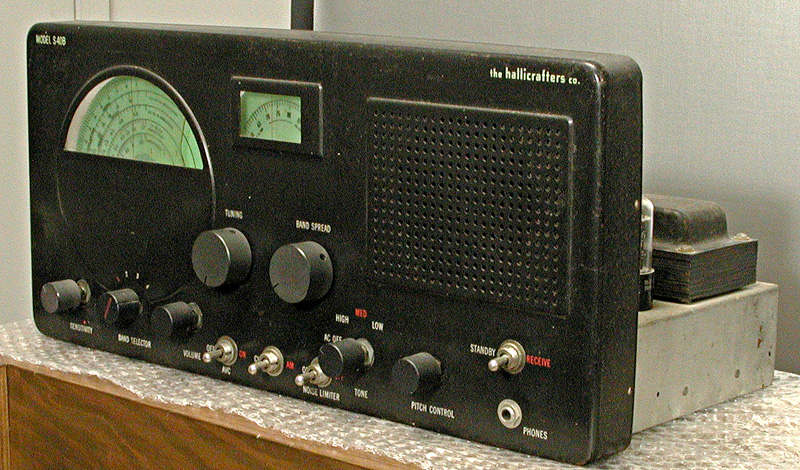
Emboldened by my success with the Sony, I decided to try to revive my Hallicrafters S-40B
(the one my father brought home in about 1965; it was built about 1954).
The other day I turned it on and there was an awful smell and a small puff of smoke.
Naturally I turned it off immediately and said to myself, "The electrolytic filter
capacitor has shorted and has probably taken out a resistor that feeds into it."
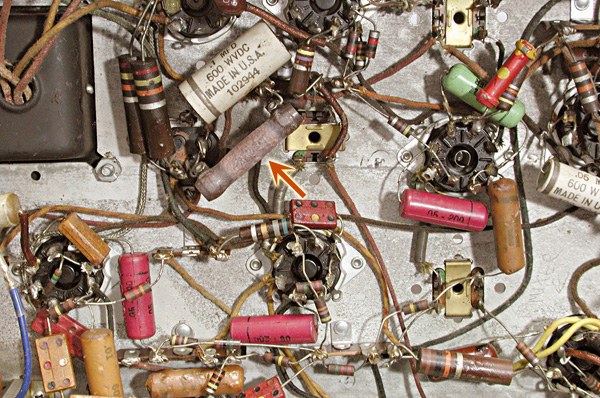
To my credit, that's exactly what had happened. Unfortunately, I don't have
any 450-volt electrolytic capacitors lying around — and look at all those
wax-paper capacitors that also need to be replaced to make the radio safe to use.
I last used this radio seriously around 1990, at which time it got a new set of knobs.
I had overhauled it around 1985, at which time it was almost fully up to spec
(the top band was very weak). Sadly, around 1980, while I was away at graduate school,
my mother discarded the outer enclosure, not realizing it went with a piece of equipment
that I still had. Prior to that, I remember replacing the audio output transformer
around 1975. Oddly, I don't think a tube has ever burned out.
I'm definitely keeping this radio as an antique, but, sadly, for a while it's not going
to be a working antique; I'm too busy to work it over. I know about
Antique Electronic Supply, and I know
that high-voltage capacitors are still easy to get; with some work, this could still
be an excellent receiver. For now, it's tagged "Do not apply power."
Old age is taking its toll — on my electronic equipment, I mean.
Lots of things that were mildly out of date, and still quite usable, when I built up
my ham radio station and workshop circa 1988-90 are now seriously
out of date. (It's been nearly
twenty years.)
If nothing else, the electrolytic capacitors in old equipment can be
relied on to deteriorate, and classic radios like this one need restoration,
not just repair.
Permanent link to this entry


|

|
2008
January
21
|
How to detect and replace the commonly blown transistor
in the Sony ICF-2010 front end
I've been working on my trusty (vintage 1987) radio again... Here's something I wrote
more than 15 years ago, which has been distributed all over the world but never placed on my
own web site. Note the 1992-vintage newsgroup routing codes.
Also see the rest of today's Notebook entry, and the additional
shortwave notes at this link.
From cbfsb!att!linac!uwm.edu!zaphod.mps.ohio-state.edu!sol.ctr.columbia.edu!emory!athena.cs.uga.edu!mcovingt Sun Apr 5 16:26:04 EDT 1992
Article: 17074 of rec.radio.amateur.misc
Xref: cbfsb rec.radio.shortwave:14875 sci.electronics:27585 rec.radio.amateur.misc:17074
Path: cbfsb!att!linac!uwm.edu!zaphod.mps.ohio-state.edu!sol.ctr.columbia.edu!emory!athena.cs.uga.edu!mcovingt
From: mcovingt@athena.cs.uga.edu (Michael A. Covington)
Newsgroups: rec.radio.shortwave,sci.electronics,rec.radio.amateur.misc
Subject: How to detect and fix common Sony 2010 problem
Summary: Fried JFET easily replaced with Radio Shack MPF102
Message-ID: <1992Apr4.184635.17406@athena.cs.uga.edu>
Date: 4 Apr 92 18:46:35 GMT
References: <1992Apr1.151210.1131@ciit85.ciit.nrc.ca> <10190011@hpuerca.atl.hp.com> <1992Apr4.171730.9192@athena.cs.uga.edu>
Organization: University of Georgia, Athens
Lines: 76
HOW TO DETECT AND REPAIR THE
COMMONLY BLOWN TRANSISTOR IN THE SONY 2010
Michael Covington, N4TMI
(Free distribution; you are welcome to copy and distribute
this document.)
As is well known, transistor Q303 in the front-end of the Sony ICF-2010
general coverage receiver is easily damaged by static electricity.
Here is information on how to diagnose and fix this problem.
WHAT ARE THE SYMPTOMS?
A 10- to 20-dB loss of sensitivity on AM (longwave, medium wave, short
wave). If you have a good antenna you may not even notice the loss.
In all other respects the radio functions normally.
HOW DO I TEST IT?
If you buy a used 2010 it's a good idea to perform this test even if you
do not notice a performance problem.
[Note added 2008: You should also perform the test if you
haven't done it for several years, to see if your radio has developed
trouble without your knowledge.
I am told, but cannot personally confirm, that the following method works
to perform a rough test without a voltmeter:
With no external antenna connected, and the built-in antenna retracted,
tune to 1620 kHz and then slowly up to 1620.1 or 1620.2. If the level of
hiss drops off sharply, the FET is probably OK. If there is no change,
the FET is probably defective.]
Remove the back cover and locate transistor Q303, near the antenna input.
Identify its three terminals (D, G, and S).
Now measure the voltage from each of those terminals to ground, with the
receiver turned on and receiving shortwave. (A convenient ground connec-
tion is the outer part of the antenna jack.)
The voltages should be: S 0.2V G 0.0 V D 2.9 V
Note especially the drain (D) voltage. If it is substantially lower than
2.9V, the transistor is leaky. (Mine measured 1.6V when defective.)
If it's substantially higher (like 4.5V), the transistor is open.
HOW DO I FIX IT?
The popular MPF-102 transistor, available at Radio Shack, is a suitable
replacement. (Sony used a 2SK152, not widely available in the U.S.A.)
Simply unsolder the old transistor and install the new one, then check
voltages again. No alignment is necessary.
HOW DO I PREVENT FURTHER TROUBLE?
By connecting the shortwave antenna through a protective diode network,
as shown below.
\|/ Antenna
|
+-----------+--------+----------------------------> tip of plug
| |
\ / --- Sony 2010
--- / \ Four 1N914 or antenna
| | 1N4148 diodes jack
\ / --- (do not substitute)
--- / \
| |
+-----------+--------+----------------------------> sleeve of plug
|
-------
-----
--- Ground (optional)
The diodes limit all voltages going into the receiver. Use the
specified types; other kinds would produce loss of signal, signal
mixing (resulting in image frequencies), or both.
The 2010 has a built-in protective diode network connected to the
built-in telescoping antenna but not the antenna jack.
[Note added 2018: I no longer recommend this modification.
See April 22, 2018 for alternatives.]
--
==========================================================================
Michael A. Covington, Ph.D. | mcovingt@uga.cc.uga.edu | ham radio N4TMI
Artificial Intelligence Programs | U of Georgia | Athens, GA 30602 U.S.A.
==========================================================================
That is not my current e-mail address above.
Permanent link to this entry
Sony ICF-2010 headphone jack repair
The headphone jack in my Sony ICF-2010 recently disintegrated into a pile of
plastic shards, and it's an unusual type; the replacement is no longer
available, even from Sony.
So I worked out how to use a more widely available jack. Here's what's
involved.
(1) Desolder the old headphone jack. It attaches to the PC board in 4 places.
Connect the upper two of these together so there will be sound in the
speaker. (By the upper two, I mean the two nearer the top of the radio,
not connected to resistors. No harm will result if you connect the
wrong ones temporarily.)
(2) If you don't want a headphone jack, you can leave it at that.
Otherwise, get a modern "closed-circuit" headphone jack such as
Radio Shack 274-246
or
Mouser 161-3504.
You will find that you can mount this in the hole left by the original
headphone jack; you'll attach it to the enclosure rather than the circuit
board, of course, and orient it so its connection
terminals are down, toward the
front of the radio and away from the circuit board.
Wire it as follows:
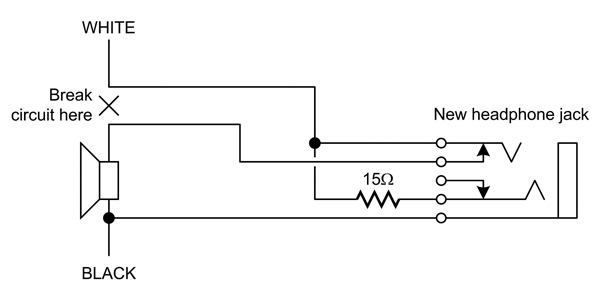
That is, at the speaker, find the white and black wires and interrupt the white one,
then proceed as shown in the diagram.
The 15-ohm resistor is a trick of mine: it lets you connect stereo headphones and
hear sound in both ears, but at the same time, you can use mono headphones without shorting
out the audio signal. Admittedly, the volume in the two ears is not equal; the right
ear gets more sound, but the difference is not large.
One more note:
If your Sony ICF-2010 goes dead while you're working on it and won't turn on,
but its front panel clock is still running, you may have simply hung its computer.
The cure is to remove all the batteries and let the computer reset.
If you've installed a memory backup capacitor (as I have), you must discharge it.
Permanent link to this entry


|

|
2008
January
20
|
Snow?

Here's a weather forecast you don't see every day, or even every decade,
in Athens, Georgia. As I write this (4 p.m. Jan. 19), Atlanta has had quite
a snowfall, but all we're getting in Athens is a chilly light rain (36 F).
Nonetheless, activities are cancelled all over town, the University has
officially closed the few things that were open on Saturday (e.g., libraries),
and tomorrow morning's church service
will be at 2 p.m.
Permanent link to this entry
Nevæda, formerly Nevada?
The people who run the State of Nevada want to change the pronunciation of its name.
They're insisting on "ne-VAD-a" rather than "ne-VAH-da." (In phonetic symbols,
the sound they want is [æ].)
I'm not at all sure why they're doing this,
but it strikes me as a rather unpleasant anti-Hispanic
gesture. Nevada was part of New Spain, and before that, it was part of the
Aztec Empire, long before English-speaking people settled there. It shouldn't
be ashamed of having a Spanish name.
The only reason to say ne-VAD-a is to show the world that you don't speak Spanish,
y eso yo no quiero hacer.
We still unashamedly use the (18th-century) French
pronunciations of Illinois and Arkansas (not quite the same as modern
French). I'm going to keep pronouncing Nevada the original way too.
In California, some Spanish pronunciations have survived (San José,
San Diego, and especially La Jolla, pronounced "la hoya").
On the other hand, Los Angeles has been pronounced four ways.
The Spanish pronunciation, "los AHN-hey-lace," is no longer heard in English.
In the 1920s some people started saying "loss ANGLE-us," but it
didn't catch on.
During my lifetime another pronunciation, "los AN-je-leez," has died out.
Today it's "loss AN-jel-us," which is one I would never have guessed.
Permanent link to this entry


|

|
2008
January
19
|
Yes, I do want a credit-card receipt
Several times recently I've been asked whether I wanted a receipt for a
credit-card purchase.
The answer is of course I do, because otherwise I have no proof
of the amount charged!
If someone steals my credit card, I'd like to have more
than just my memory to tell me which charges are legitimate.
And I'd like to have proof that I paid for the merchandise.
Well... My attempt to get a few groceries this afternoon (Jan. 18) ran into
a surprising difficulty.
I went to a local grocery store (which I won't name here)
that had recently been the scene of a violent
crime, plus another subsequent attack on a police officer.
It's a prosperous-looking place, and I figured it was probably still safe.
Sure enough, no crimes occurred while I was there.
But an odd and frustrating thing did.
I used a self-checkout machine which claimed it was printing a receipt but
did not actually deliver it to me.
The sign said to go to the attendant if the receipt fails to print.
I thought this meant the attendant would give me a receipt,
but no such luck!
The attendant told me that receipts are only printed when the purchase
exceeds $50 (which, I was subsequently told, is false).
Eventually, someone in Customer Service retrieved a computer printout
of my receipt and I was on my way, perhaps never to return.
I know that younger people often don't want credit-card receipts.
But didn't the store need to give me one, to prove that I'd paid for
the merchandise? What if I'd been challenged at the door?
I wonder how much of the recent crime wave is connected with the store's
apparent function as a haven for shoplifters. People routinely
walk out with bags of merchandise and no receipts because receipts aren't
regularly given, and employees think the lack of receipts is normal.
Despite the armed guard at the door,
there's no way to tell whether a customer has paid or not.
Permanent link to this entry
Multiple what?
Psychiatrists tell us that multiple personality disorder is extremely
rare; some of them say it occurs only in the movies.
But our former football star Herschel Walker claims to have it,
and the media are saying the same thing about Britney Spears.
Should we believe them? Let me just observe that fluctuations in behavior are
not the same thing as multiple personalities.
Permanent link to this entry


|

|
2008
January
18
|
Sorted by shirts
Today (Jan. 17), when I taught class (LING 8570) around a conference table,
the students sorted themselves by shirts.
From left to right, I saw 2 deep red sweaters, then 2 almost identical
rugby shirts, then 3 blue shirts of somewhat varying types.
They claim it wasn't planned — they did it all unconsciously.
Should I believe them?
Permanent link to this entry


|

|
2008
January
17
(Revised)
|
A question of picture size — Resolved.
Never mind the query that was posted here earlier. My eager public told me that:
- More than one person reads the Daily Notebook on a screen 800 pixels wide.
- More importantly, 800 pixels is the right width for my layout; if it's much
wider, the text becomes hard to read because the lines are too long.
I was frustrated by the occasional need to display larger pictures.
But I think I've solved the problem and improved legibility.
I've locked the width of wrappable text paragraphs at 600 pixels, maximum. No matter
how wide your screen is, the lines of text will no longer rewrap to fill them.
And when I need to display a wider picture, I just put it in, like this:

and you can scroll to the right, if necessary, to see it.
If absolutely necessary, I can also shift a picture into the left margin like this:
|

|
| |
but that is not going to be a common practice. (I want to thank Bruce C. Baker for
useful suggestions.)
You will also notice a few other minor improvements to the layout today.
Permanent link to this entry


|

|
2008
January
16
|
How to read an e-mail header
(to tell whether e-mail is fake)
[Information added after original upload.]
Fake e-mail claiming to be from banks, large businesses, eBay, or Paypal
is now so common that it's disrupting people's everyday business.
Here's a short tutorial on how to read an e-mail header so you can tell
where the mail actually came from.
Please feel free to share
this link with others so they can read this information
for themselves.
Every piece of e-mail includes a header, but you
have to figure out how to get your e-mail software to show it to you. Look around in its menus and
help system. Sometimes what you have to do is right-click on a message
and choose "Properties."
When you've found the header, here's the kind of thing you'll see:
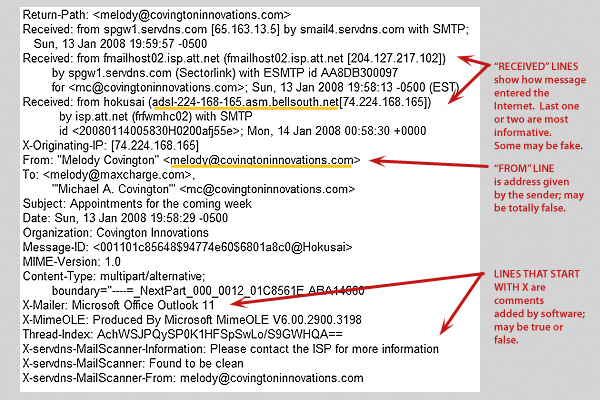
Note the "From:" line, which is whatever address the sender claimed to have,
and the "Received:" lines, which tell you how the e-mail actually got to you.
I've seen people add fake "Received:" lines, but they can't prevent the genuine ones
from being put in, so look carefully.
When the message is from a small business or private individual, discrepancies are
not necessarily a bad sign. For example, e-mail from covingtoninnovations.com
always originates from either bellsouth.net or servdns.com because Covington Innovations
doesn't run a mail server; we use our two ISPs.
But big businesses that run their own e-mail systems, such as eBay or Bank of America,
should always show an origin address in their own domain.
Especially, look for foreign countries that shouldn't be in the list.
If you're in Ohio and you're getting e-mail from Bank of America, it shouldn't
go through Russia (.ru), or China (.cn), or Taiwan (.tw),
or even an American university (.edu).
You should see a relatively short chain of computers, all of them American commercial sites
(.com or .net).
And it goes without saying that such a message won't come from a major consumer service
such as Gmail or Yahoo.
Anything named dsl or adsl is probably the address of a DSL line to a
home computer. This is to be expected on e-mail from individuals but not large
businesses.
Numeric addresses that start with 192.168.1 are individual PCs inside a network;
these addresses are assigned by the local router and don't tell you where the computer
is located. The next step up the line will tell you how it's attached to the Internet.
The dates and times are in different time zones and are marked as such.
The most common ones are +0000 (Greenwich Mean Time, used worldwide),
-0500 (Eastern Standard Time), and -0800 (Pacific Standard Time).
Naturally, if you see +0700 on a message that claims to be from the United States,
you should be suspicious because that's an Asian time zone.
Now let's analyze a fake...
Below is the header of an actual piece of fake e-mail I received this morning.
As you can see, it claims to be from the Internal Revenue Service
but was actually mailed from a home DSL line on Southwestern Bell (swbell.net).

The content of the message tells me to click on a link
that claims to be the IRS but actually goes to an FTP site in India.
Here's what I found out by opening the message:
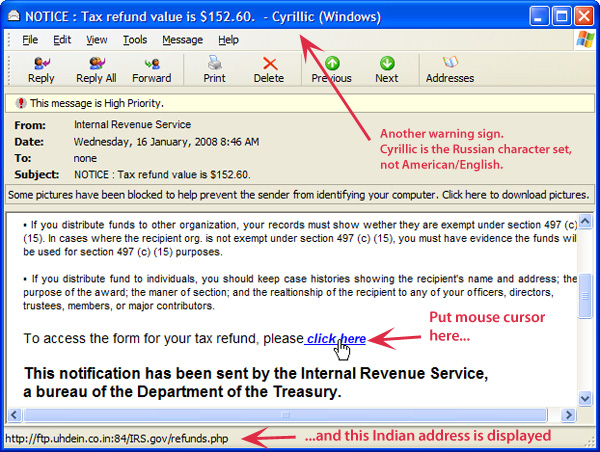
Crucially, if I put the mouse cursor on the link but don't click,
the address is shown at the bottom of the window, and it's definitely
not irs.gov!
(Look carefully. Yes, the address has "irs.gov" in it, but that's just a file or
directory name. The actual location is
the first part of the address, before the slash, and is "ftp.uhdein.co.in".)
This is an example of "phishing" — if I were to click through, I'd probably
see a fake IRS form that asks for my bank account numbers or other financial information.
Now then. Why don't we hunt down the sender, on Southwestern Bell?
We have the ADSL address; Southwestern Bell could track it to the individual house.
Why? Because that person is probably an innocent victim.
It's almost certainly someone whose computer is infected with a virus that automatically
sends out this e-mail, at the behest of the Indian con artist, without his even knowing it.
And that's why you need virus protection — not just to make your computer work more
reliably, but also to keep it from becoming a pawn of organized crime.
Permanent link to this entry


|

|
2008
January
15
|
An amusing 1930s workshop manual
Have a look at
The Laboratory Workshop,
by Duckworth, 1933.
This is a "tools and how to use them" kind of book aimed at high school
science departments.
It's delightfully disorganized; for instance the plumbing section doesn't mention turning off the
water until halfway through, as an afterthought.
And it's delightfully mispunctuated; all the semicolons somehow turned into commas.
But it's also chock-full of information, recent enough to be useful and
antiquated enough to be full of things that are now esoteric.
Most people will probably want to download the
PDF version
of the text, but it is also offered in several other formats, all free.
Permanent link to this entry
What R you?
The statistical software package
R is
taking the academic world by storm, and I'm about to start learning how to use it.
Its great attraction? Besides being good, it's free.
Permanent link to this entry


|

|
2008
January
14
|
Shortwave radio miscellany
[Minor updates after initial upload.]
I've been a shortwave listener (SWL) ever since my father brought home a Hallicrafters S-40B
when I was 8 years old.
For the past 20 (!) years I've used a Sony ICF-2010, now highly modified (memory backup
capacitor added, static protection diodes added,
Kiwa wide filter
in place of its "narrow"
filter so that the settings are now "wide" and "not quite so wide").
I've just done one more modification, which is to
disable the audio narrowband filter
to keep the sound from being muffled on "narrow."
(The way I actually disabled it was much simpler than theirs; I removed capacitor C83.
The Sony ICF-2010 service manual is available here
and is needed to identify the parts.)
Meanwhile, here are some more shortwave goodies.
What stations are still worth listening to on shortwave?
Passing by a lot of idiosyncratic religious broadcasters in North America,
we have two good Christian stations,
WEWN (Roman Catholic) and
HCJB (mainstream evangelical,
but no longer in English, only Spanish).
The
BBC
no longer has a shortwave service to North America, although its
broadcasts to Central America still come in.
Deutsche Welle,
Radio Netherlands (very strong from Bonaire in the Caribbean)
and the Voice of America are still going.
So are a few others.
Lots of schedules are aggregated on the Web
at www.bclnews.it.
What happened to the shortwave broadcasters?
Well, if you just want to hear them, and you're near an Internet
terminal, they're all on Internet radio. But I like shortwave for 2 reasons: I'm soon going
to be able to listen to it in the car, and it won't go away if there's an international
crisis. The Internet depends on a good bit of international cooperation. Radio waves, however,
go straight from transmitter to receiver, bouncing off the ionosphere without relying on
any third party.
The other thing that happened is that we're at sunspot minimum right now; the ionosphere
doesn't work so well, and everyone has been shifting to other means of communication.
I predict an upsurge of shortwave broadcasting over the next four
or five years.
Meanwhile, for shortwave nostalgia, look at
this collection
of interval signals and station IDs. (An interval signal is a musical passage
played repeatedly during the five minutes before the beginning of a broadcast.)
My favorite?
Radio RSA, Johannesburg, which combined music with birdcalls.
Others familiar from my younger days include
the BBC World Service
(and the song "Lilliburlero"),
the Voice of America
(which really got some mileage out of "Yankee Doodle," and, much earlier,
"Columbia, the Gem of the Ocean"),
and of course
Radio Havana,
which still blankets the Southeast.
And they have some vintage items such as
the BBC in 1945
(presumably from a phonograph record)
and
this clip
of Radio Prague during the Soviet invasion of 1968.
Permanent link to this entry


|

|
2008
January
13
|
Westphalian wars?
One of the most interesting papers at the conference (unfortunately I don't remember whose)
pointed out that almost all wars are non-Westphalian. Now what on earth does that mean?
At the Treaty of Westphalia, 1648, the major powers of Europe got together and (supposedly)
agreed that all nations should be like England and France, i.e., sovereign and self-contained,
with police powers inside their borders but not across international boundaries.
The idea was to rule out loosely organized
local powers that fell short of nationhood, tribal powers without
definite boundaries, and, at the other end of the scale, empires that claimed the right to
conquer territory anywhere they went.
The Westphalian nation-state concept was an important issue in the American Revolution.
We wanted to be "a new nation" rather than a colony. We were struggling with the question
of how a new nation comes into existence.
Well... Our speaker pointed out that the Treaty of Westphalia didn't really "take."
Colonial empires were still being dismantled until the 1970s. Loose local confederations and
tribal powers are certainly still with us.
And, to this day, most wars are non-Westphalian. The great majority of wars in modern
times are directed at non-nations, such as the Viet Cong or, most recently, al-Qaeda.
As for the notion that it's wrong to cross a national boundary to defend yourself,
we have to remember that that's not one of the Ten Commandments. It's part of a 1648
treaty to which few powers actually subscribe. I suppose we can thank Hitler for upholding
the Treaty of Westphalia by breaking the rules so cleanly that he got the entire world to
fight him at once! He was, of course, trying to complete the Westphalianization of Germany,
along with other much less laudable goals.
Permanent link to this entry


|

|
2008
January
11-12
|
Short notes
I've just finished attending the Conflict Processes Summit, a conference
at the University's
terrorism lab.
The scientific study of how wars start is an important business.
I met people who have interviewed IRA and PLO terrorists in their
headquarters, people who have tabulated thousands of incidents and
created revealing statistical models...
My contribution is going to be software
to read newspaper articles and collect information about the events
reported in them.
What a lot of people don't realize is that
you can test theories about strategy.
For example, is it better to negotiate with kidnappers or to follow a strict
no-negotiation policy? Study of actual incidents will tell you
which one makes the kidnapping rate go up or down.
It's not just a matter of opinion.
Shortwave for the car:
Two Sony CDX-GT260S radios are on the way to us
from
this eBay store in Singapore, which sells
mainly to Australians.
(Sony doesn't sell this radio in the US.)
These are, of course, dandy AM/FM/CD players (with aux input and MP3
capability), and they also receive shortwave broadcasts.
More news when they arrive. I'm not expecting them to pull in
distant stations, but there are strong Spanish signals on the air here,
broadcasts coming out of Cuba and broadcasts aimed into it,
and I need to shake the rust off my Spanish by listening to something
more coherent than just the local latino stations clowning around.
The installation will be trivial since we're replacing other Sonys,
one mounted in the same bracket (so replaceable without even opening the dash)
and one with the same wiring but a different bracket.
Permanent link to this entry


|

|
2008
January
10
|
Current events
The Iowa caucuses are
weirder than you imagined.
They're nothing like a primary election.
They're a system to get people to
support the candidate that they think will please their neighbors.
That may how Huckabee did so well.
One more banking regulation we need:
Payments on loans
cannot be due on days when banks are not open.
(Or if they are, payments the next business day have to count as on time.)
Common sense? Not common enough.
Although I favor consumption taxes in general,
there are said to be
terrible
technical flaws in the proposed FairTax. Indeed, the transition from an income tax system to a
consumption tax system is very hard to make; we should phase it in over 100 years!
[Note, Jan. 12-18]: I know all of this is disputed.
A lot of the dispute has to do with how much prices will fall when the changeover takes place,
and also how much wages will fall. The optimists think prices will fall more than wages.
Others aren't sure. See now the detailed rebuttal
here.
Permanent link to this entry
Golf at hard labor?
A couple of years ago I read an amusing magazine article about
"preposition golf",
defined as the new fad for giving golf courses
(and other fashionable developments) names of the form
The [Noun] At [Adjective] [Noun].
If you're a golf course,
your name has to be The Links at Tall Pines, or something like that;
a name like Tall Pines Golf Course is so last-century.
Well... I don't know the story behind Hard Labor Creek, not too far
from here, but it's the site of a state park, an observatory, and a few
other things.
And — I saw it the other day — The Links at Hard Labor.
Haven't people ever heard phrases like
"two years at hard labor"?
Do they know what they mean?
Permanent link to this entry


|

|
2008
January
9
|
Surfing the Web automatically
Why surf the Web yourself when you can make your computer do it without you?
After testing several competing products I am pleased to recommend
iMacros from iOpus as an extremely
useful web automation suite that can see through Java, Flash, and even graphics.
More about this later... I got involved because some colleagues need to collect
news wire data automatically from a rather intricate web site.
Basically, iMacros records a session, and you can either play back the
transcript or edit it to make it more versatile. It's also scriptable
from C#, VBScript, and other languages.
Permanent link to this entry
Semester starts with a bang
I won't be writing much for several more days. We have an unprecedentedly
large turnout for CSCI 8570 —
today there were 15 people either on the roll, or in the room, or both.
I was expecting 3 to 5. And the rest of the semester's activities are starting up
with equal force. Hang onto your hats!
Permanent link to this entry


|

|
2008
January
8
|
Typing foreign languages with the Windows US-International Keyboard
If you often need to type words like résumé or
Dürer or mañana, you should probably be using
the Windows US-International keyboard layout, which is documented
fully in Wikipedia.
Here's what you do. Go to Control Panel, Regional and Language Options,
Languages, Details, and add United States—International to your available keyboard
layouts. You can keep or delete the regular US layout. If you keep it, a small icon
will appear at the bottom of your screen on which you can click to change keyboards on
the fly, and when you do, the keyboard change will only apply to the current window.
That way US-International won't bother you when you don't want it to.
When US-International is selected, two things happen:
- You can type ä á à â ñ by typing "a 'a `a ^a ~n respectively.
To type " by itself, press " and then the space bar or any letter with which it does
not combine; the same goes for the other accent marks.
- The right-hand Alt key has a new function: it selects the blue items in the chart
below. The left-hand Alt key is still Alt.

My only disappointment with US-International is that there is no way to type macrons
(the long-vowel marks used in Latin) and, as far as I can make out, no easy way to
create a custom keyboard layout of my own.
Permanent link to this entry


|

|
2008
January
7
|
Chicago, the practical city?
I've just attended the Linguistic Society of America annual meeting
in Chicago. Melody came along and we stayed in the Chicago Hilton
(Conrad Hilton).
I have another conference coming right up, so I won't have time to
write a lot for several days...
Impression of downtown Chicago: Clean and practical. I suppose
it's the result of decades of "downtown revitalization," but this
is not a "grungy northern city." I walked from the south end
of the Loop to just past the Wrigley Building. Everywhere was
clean and well-kept and seemed relatively safe (though I didn't lower
my guard). I was not confronted with any obnoxious behavior, graffiti,
pornographic posters, or anything like that. There were a few beggars,
but they were rather restrained.
This place makes Atlanta look very small. It even makes Manhattan look a
bit cramped and very quirky.
I was treated courteously by everyone in the whole city.
Where's the northern brashness? Not evident. This isn't New York, folks.
One of the highlights was my visit to Central Camera Company
(established 1899), a good old-fashioned camera store, full of photographic
gear old and new. I bought a Manfrotto tripod head for Melody to use photographing
agricultural equipment.
It's one of the least romantic things I've ever bought her, but she
likes it.
Permanent link to this entry
The "Free Public WiFi" scam
I'm sitting in Chicago's Midway Airport and my laptop has found a
network called "Free Public WiFi." The airport does not actually
offer free public WiFi; they have a pay-by-the-day WiFi network
named Concourse.
Further, "Free Public WiFi" is an ad hoc network, i.e., device-to-device.
It is not an Internet access point.
In other words, somebody has set up his laptop to broadcast the
name "Free Public WiFi" in the hope people will connect to it and
he can then copy whatever is unprotected on their computer.
The person whose laptop is broadcasting "Free Public WiFi"
may be an innocent victim. Once you've connected to such a network,
your computer is likely to try connecting to it again — and because
ad hoc networking is symmetrical, that means your computer is also soliciting
connections under the same name. Details here.
The cure is to make sure you've removed it from the list of network profiles
stored by your wireless software.
Permanent link to this entry
A SpamCop malfunction
If your e-mail reaches you through any service that relies on
spamcop.net, you may not have gotten all of it recently.
Last night (Jan. 5), in Chicago, I was using MailWasher to check mail,
and all of a sudden a lot of perfectly legitimate mail — even
tracking notices from UPS — was flagged as spam. Fortunately
MailWasher did not delete it automatically. I turned off SpamCop access,
had MailWasher recheck everything, and the problem cleared up.
I don't know if SpamCop has returned to normal yet.
Permanent link to this entry


|

|
2008
January
3
|
Short note
I'll see you again in a few days. In the meantime, enjoy
this online collection
of mechanisms (machine subsystems) — both diagrams
and working models.
Permanent link to this entry


|

|
2008
January
2
|
Comets amid scenery
I spent the final hours of 2007 photographing two comets amid celestial scenery.
Here's Comet 8P/Tuttle next to the spiral galaxy M33:

Single 3-minute exposure with Canon EOS 40D, Sigma 105/2.8 DG EX lens at f/5.0, piggybacked on
my telescope, corrected against dark frames and flat fields. The rapid motion of the comet
precluded stacking multiple exposures.
A day earlier, it was cloudy here, but the comet appeared much closer to the galaxy.
And here's Comet Holmes, now bloated to 3 times the apparent size of the full moon
(making it, in real life, something like 3 or 4 times the diameter of the sun, and thus
the largest object in the Solar System, although it's mostly just a cloud).
To the right is the star cluster M34 in Perseus.

This is a stack of three 3-minute exposures, processed like those of Comet Tuttle.
Permanent link to this entry
Why do they drop a ball in Times Square...?
Why do they ring in the new year by dropping a ball on a pole in Times Square?
The answer: Dropping a ball is a traditional way of signaling the time to
ships in port,
to enable them to set their chronometers.
And, of course, chronometers
(clocks) are necessary
for navigation if you want to determine your longitude.
You can find latitude by just looking at the stars, but for
longitude you must also know how far the earth has rotated beneath you,
so the development of chronometers that would run accurately for months at sea
was a triumph for navigation.
Permanent link to this entry
Ideas needed...
To reclaim storage space, I'm looking for a home for a collection of magazines.
Although I haven't taken a detailed inventory yet, I have QST (Amateur Radio)
complete from
1990 to near the present date, Popular Photography complete for several years
in the late 1990s, Dr. Dobb's Journal for much of the 1990s if not more, and
some sporadic issues of PC from the 1990s. All of these are available to me
at the University Library and are not likely to become rare or collectable, but they're
too good to just throw out. If anyone knows where these would find a good home, please
let me know. (No vague suggestions, please; I can already think of possibilities;
I want definite leads.)
Alert readers will note that this entry was uploaded early in the day on Jan. 1.
The Daily Notebook will be somewhat sporadic until mid-January because I'm busy with
other things. There will probably be an entry for Jan. 3, then a gap for a few days.
Readers, thank you all for your support!
Permanent link to this entry


|

|
2008
January
1
|
Going, going, gone...
 By the time you read this, the first wave of my
eBay sale will be in its final hours.
Seize the opportunity!
My plan is to sell more items in the coming weeks.
Some of them may even be as strange as the current ones.
By the time you read this, the first wave of my
eBay sale will be in its final hours.
Seize the opportunity!
My plan is to sell more items in the coming weeks.
Some of them may even be as strange as the current ones.
Permanent link to this entry
Possum!

What has the snout of a pig, the teeth of a shark, the face and body of a cat,
the tail of a rat, and the reproductive system of a kangaroo,
and catches and eats rattlesnakes, to whose poison it is immune?
Clearly a joke perpetrated by our Creator.
But this one seems to have taken up residence in our compost bin, to the
considerable annoyance of Babbage and Tycho.
This picture was taken under unusual circumstances. In the dark, I walked up to the bin
and aimed the camera in. It blinked its autofocus light, focused, and fired the flash.
Result: A perfectly focused and exposed picture. Canon EOS 40D, built-in flash, Canon 28/2.8 lens.
Permanent link to this entry
Kabinkabink! Kabinkabink! Kabinkabink!
(Must everything beep?)
Back in 1978, while visiting Arthur Christian in Cheshire,
I breadboarded a TTL gated oscillator, which produced a satisfying beep-beep-beep
sound in a speaker, and immediately said to myself: "This is a sound that hasn't been common until
now, but for the rest of my life it's going to be very common because with digital ICs,
it's so easy to make."
I was right. Nowadays everything beeps. Even the machine in the library for depositing money
to our copy-card accounts — it makes a "beep beep beep" that disturbs the whole room whenever
anybody uses it. Somebody wasn't thinking.
Closer to home, I've just put a new Sony stereo system in Melody's minivan, and, like the Sony that
inhabits my Oldsmobile, it has an uncouth habit. Whenever you turn the car off, whether the stereo
is on or not, it goes kabinkabink! kabinkabink! kabinkabink! in the speakers.
That is Sony-language for, "Help! You've left my removable faceplate on! Take my faceplate off
or the New York thieves will get me! I'm scared!"
Poor Sony stereo doesn't know it's not in New York. And there's no way to disable the beeping
from the control panel. (Has anyone worked out a hardware modification to do it? If so I'd like to hear
from you. The kabinkabink noises are delivered by powering the amplifier from the unswitched
12-volt line. There's probably one diode, or something, that I could take out to disable this.)
One of the great follies of the digital era is the notion that everything should beep.
The other great folly is the practice of providing hidden controls ("press this button
for 2 seconds, then press the other button twice, and voilà! that's how you
set the clock"). I'll rant about that some other time.
Permanent link to this entry
Interesting products I've seen lately
Weatherproof
laser-printer label stock available
as uncut 8.5×11-inch sheets. You could use this to cover the entire
front panel of a piece of electronic equipment, labeling all the controls.
I made a bumper sticker
out of this material about 8 years ago and it has been on my car
ever since; it's still only slightly worn.
(And what does my bumper sticker say? "Covington Innovations," and it's just 3
inches wide. I really made it just to test the label material.)
A car
stereo that gets international shortwave broadcasts
as well as AM and FM, and of course it also plays CDs.
If it weren't quite so expensive I'd have to have one, for language practice.
Reception is probably not too good in town; it's mainly something to listen to
during long drives to rural astronomy sites.
It's a Sony, so I presume it goes kabinkabink, but that doesn't totally
rule it out.
Permanent link to this entry
The ravages of time
For those who feel that the new year should begin with a memento mori,
I present this picture of the ravages of time.
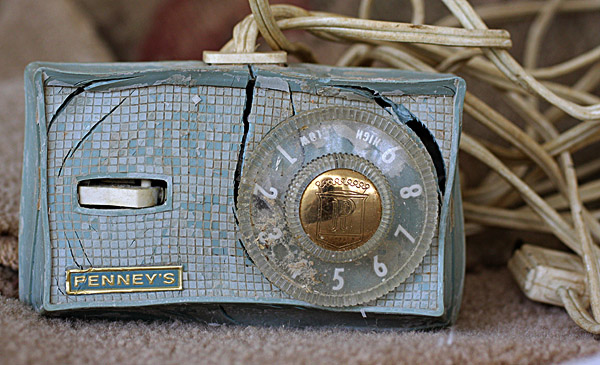
This was the first electric-blanket controller I ever saw, circa 1959, and (along with
the blanket, of course) it kept me warm in winter until the early 1970s. Then it was put
in the attic, and as you can see, 30 years in a hot attic were not kind to its plastic
enclosure. I rediscovered it a couple of days ago while cleaning out the attic.
I think it's ready to go into the trash...
Happy new year, everyone!
Permanent link to this entry


|

|
| |
Entries are most often uploaded around 0000 UT on the date given,
which is the previous evening in the United States. |
|
